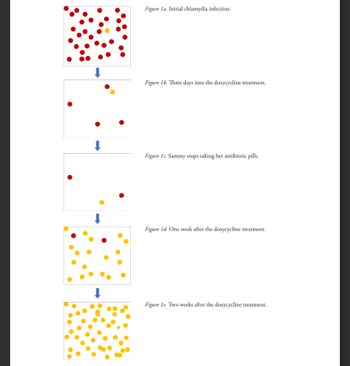3. What would a growth curve of the chlamydia bacteria look like starting from Sammys initial infection? Draw a simple graph and indicate where (a) her antibiotic treatment started, and (b) two weeks post-treatment.
5.The following is a partial ribosomal DNA sequence of a chlamydia gene that encodes for one of its ribosomal proteins. Blood samples were taken from Sammy before and after she started the antibiotic treatment, and there is a change between the two populations. Please identify the point mutation and the amino acid that changed, and provide one reason why a ribosomal mutation could affect antibiotic resistance to doxycycline.
Pre-antibiotic treatment: ATG-GCT-GCT-AGC-GCT-TCA-AAG-GGC-AAG-AGT-AAA
Post-antibiotic treatment: ATG-GCT-GCT-AGC-GCT-TCA-AAC-GGC-AAG-AGT-AAA
6.


Step by stepSolved in 1 steps

- 8. You infect E. coli cells with two strains of T4 virus. One strain is minute (m), rapid lysis (r) and turbid (t); the other is wild-type for all three markers. The lytic products of this dual infection are plated on a lawn of E. coli and the morphology of the plaques are classified. The resulting 10, 342 plaques were distributed among eight phenotypes, as follows: mrt 3467 +++ 3729 mr+ 853 m+t 162 m++ 520 +rt 474 +r+ 172 ++t 965 You decide to repeat the exact same experiment as outlined above and this time you count and classify 25, 000 plaques? How many plaques would you expect to be wild-type for all three markers? (Hint: You will need to calculate the expected DCO class for the cross above and apply that to your answer.)arrow_forward10. When looking at your agar plate, where are the bacteria that did not take up the plasmid during the transformation? (It is a 4 letter word). Thanks for the help!arrow_forwardPlease help me, this is from practice, double check your answers, previous tutors got it wrongarrow_forward
- 13arrow_forward4. What is the name of the process by which bacteria pick up a different organism’s geneticmaterial?5. Genetically, how does the original bacterial DNA (plasmid) differ from the final bacterial DNAmolecule? (Do not say, “It is longer.”)6. Tetracycline is an antibiotic that is prescribed to kill bacterial infections. The transformedbacterial cell that you created has the tetracycline resistant gene in it. If this cell is placed on agrowth medium with tetracycline, will the bacteria grow or die? Explain.arrow_forward2. Please help answer this question and show all work, thank you so much.arrow_forward
- 6. Similar to the class notes (Intro to Genetics), a segment of DNA (shown below) contains a promoter segment (the first 9 base pairs), a ribosome binding segment (the next 6 base pairs), and a segment that codes for protein synthesis which is started by the rest of the base pairs. ACTCCATTGAACCATTTCTATGATCCGCTAACG-... TGAGGTAACTTGGTAAAGATACTAGGCGATTGC-... A. When the DNA is induced to be copied to mRNA, the top strand is coding, meaning that the mRNA makes an identical copy of the lower strand (replacing T with U) The mRNA copy starts with the ribosome binding sequence. What is the sequence of the mRNA that will go to the ribosomes? B. What are the first 6 amino acids of the protein that are coded for by the mRNA? C. What would the amino acid sequence be if... i. a transition mutation occurred on the final G in the mRNA? ii. all of the G & C bases in the protein synthesis portion had transition mutations? iii. a point deletion mutation occurred in the ATA sequence (in the lower strand…arrow_forwardRestriction endonucleases are bacterial enzymes that cleave duplex (double-stranded) DNA at specific nucleotide sequences. The mode of replication of the animal virus SV40 has been investigated by using restriction endonucleases that cleave SV40 DNA into a number of unique segments. Like most viruses, SV40 DNA is circular. The map positions of the 11 fragments produced by a pair of restriction endonucleases are shown on the next page. Immediately following a 5 or 10 minute pulse of radioactively labeled thymidine, labeled SV40 molecules that have completed replication during the pulse are isolated. These newly replicated DNA molecules are digested by the restriction endonucleases and the resulting fragments are analyzed for the relative amounts of pulse label they contain. The results are in the table below. Assume that at the time the label was added there was a random population of replicating SV40 DNA molecules in all possible stages of synthesis. From the information given below,…arrow_forward1c) T. aquaticus genomic DNA is 34.3% guanosine nucleotides. What fraction of the DNA is adenosine nucleotides? 1 0.9 0.8 0.7 0.6 0.5 0.4 0.3 0.2 0.1 Fraction of DNAarrow_forward